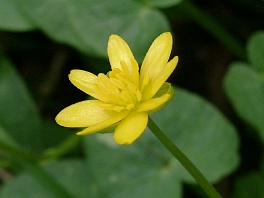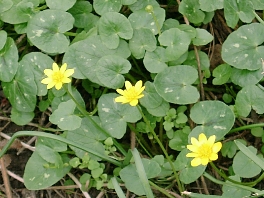 Often the Pileworth is the first green plant of the year that grows in sunny forrests.
The leaves of the Pileworth sometimes build big carpets of green.
Often the Pileworth is the first green plant of the year that grows in sunny forrests.
The leaves of the Pileworth sometimes build big carpets of green.
After the green leaves yellow blossoms appear that add shining color to the carpet of leaves. But these blossoms also show, that the leaves are becoming poisonous.
Before the blossoms show up the leaves can be eaten in salads.
They help against spring tiredness.
Medicinal Uses
- Do not overdose!
- Spring tiredness
- Lack of Vitamin C
- Scurvy
- Skin impurities
- Haemorrhoids
- Warts
- Blood cleansing
Information
| Other Names: | Lesser Celandine |
| Used Parts: | Leaves, Bulbils, Root |
| Substances: | Vitamin C, Anemonin, Protoanemonin, Tannic essence, Saponins |
| Time to collect: | Spring |
Methods

|
Beware!
The leaves of the Pileworth should only be eaten before the flowers blossom. Also they should only be eaten in small amounds. The leaves can contain sharp substances that are poisonous when eaten too much or after flowering.
|
Fresh leaves
Pileworth leaves can be eaten in small quantities as wild salad.As they contain a lot of vitamin C, they can help against lack of vitamin C and spring tiredness.
In former times, when scurvy was a common disease, people used the fresh leaves of the Pileworth against scurvy.
Dried leaves
From dried leaves you can cook a tea. You can drink the tea against problems of the skin and skin impurities.You can also use the pileworth tea for washing problem ares.
As a sitting bath pileworth-tea can help against haemorrhoids.
In the dried leaves the poisonous substances have disappeared.
Tubers
The tubers of the roots look like piles and therefore it was used traditionally to treat piles and warts.The sharp juice of the tubers can cauterize warts.
Bulbils
The bulbils that grow at the base of the stalk look like grain.In bad times people dried the bulbils and made flour out of it.
Plant description
 The Pileworth grows in sunny forrests of Europe and sometimes in North America also.
It can also grow on meadows and there are such a lot of the pileworth plants,
that it looks like carpets.
The Pileworth grows in sunny forrests of Europe and sometimes in North America also.
It can also grow on meadows and there are such a lot of the pileworth plants,
that it looks like carpets.
In early springtime the Pileworth is one of the first plants, that grows out of the soil.
Out of the tubers of the roots several stalks are growing. There are leaves, that look like round hearts at the end of the stalks. Often there are so much leaves, that it looks like a carpet.
After some time yellow flowers blossom on seperate stalks. The flowers have lots of petals, that look like stars.
When the flowers show up, the leaves are becoming poisonous. Therefore you shouldn't eat Pileworth when flowering.
Although there are lots of insects enjoying the flowers of the Pileworth it has nearly now seeds.
The propagation of the Pileworth is happening by bulbils. They grow at the bottom of the stalks. Out of this bulbils new plants are growing.
At the end of may the visible parts of the Pileworth disappear into the ground.
